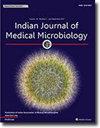Microbial profiling, antimicrobial resistance surveillance, and molecular detection of MecA gene in Staphylococcal strains from donor human milk: Insights from a milk bank investigation
IF 1.4
4区 医学
Q4 IMMUNOLOGY
引用次数: 0
Abstract
Purpose
Donor human milk (DHM) from milk banks provides vital nutrition to vulnerable infants. Understanding its microbial profile and antimicrobial resistance patterns is crucial for ensuring its safety and efficacy. This study aimed to profile the microbial composition, detect antibiotic resistance, and identify the presence of mecA gene in Staphylococcal strains from DHM samples.
Materials and method
A total of 151 DHM samples were collected from a regional human milk bank in North India. Microbial identification was performed using MALDI TOF MS, and antimicrobial susceptibility testing was conducted using the disc diffusion method. Molecular methods, including PCR, were employed for mecA gene detection.
Results
The study revealed a diverse microbial profile, with Staphylococcus species being predominant. Acinetobacter and Pseudomonas species were also prevalent, raising concerns due to their association with healthcare-associated outbreaks. High rates of antibiotic resistance were observed across both Gram-positive and Gram-negative bacteria, with resistance to commonly used antibiotics such as penicillin, clindamycin, erythromycin, and ceftriaxone. The mecA gene, associated with methicillin resistance, was detected in a significant proportion of Staphylococcal isolates.
Conclusion
The study underscores the importance of rigorous microbial analysis and antimicrobial susceptibility testing in assessing the safety of DHM. The presence of diverse microbial species, including antibiotic-resistant strains and the mecA gene in Staphylococcal strains, emphasizes the need for stringent hygiene practices and continuous surveillance in milk banks. Implementing comprehensive screening protocols and adhering to best practices in milk handling and pasteurization are crucial for safeguarding the health of vulnerable infants reliant on donor milk.
捐赠人乳中葡萄球菌菌株的微生物谱分析、抗菌药耐药性监测和 MecA 基因的分子检测:牛奶银行调查的启示。
目的:来自母乳库的捐赠人乳(DHM)为脆弱婴儿提供了重要的营养。了解其微生物特征和抗菌药耐药性模式对确保其安全性和有效性至关重要。本研究旨在分析 DHM 样品中的微生物组成、检测抗生素耐药性并确定葡萄球菌菌株中是否存在 mecA 基因:从北印度的一个地区母乳库中共收集了 151 份母乳样本。使用 MALDI TOF MS 进行微生物鉴定,并使用碟片扩散法进行抗菌药敏感性测试。在检测 mecA 基因时采用了包括 PCR 在内的分子方法:结果:研究显示微生物种类繁多,以葡萄球菌为主。不动杆菌和假单胞菌也很普遍,由于它们与医疗相关疾病的爆发有关,因此引起了人们的关注。革兰氏阳性和革兰氏阴性细菌的抗生素耐药率都很高,对青霉素、克林霉素、红霉素和头孢曲松等常用抗生素都有耐药性。在相当大比例的葡萄球菌分离物中检测到了与甲氧西林耐药性相关的 mecA 基因:本研究强调了严格的微生物分析和抗菌药敏感性测试对评估 DHM 安全性的重要性。牛奶中存在多种微生物,包括抗生素耐药菌株和葡萄球菌菌株中的 mecA 基因,这强调了在奶库中实施严格的卫生规范和持续监控的必要性。实施全面的筛查方案并坚持牛奶处理和巴氏杀菌的最佳做法,对于保障依赖捐献牛奶的脆弱婴儿的健康至关重要。
本文章由计算机程序翻译,如有差异,请以英文原文为准。
求助全文
约1分钟内获得全文
求助全文
来源期刊

Indian Journal of Medical Microbiology
IMMUNOLOGY-
CiteScore
2.20
自引率
0.00%
发文量
154
审稿时长
73 days
期刊介绍:
Manuscripts of high standard in the form of original research, multicentric studies, meta analysis, are accepted. Current reports can be submitted as brief communications. Case reports must include review of current literature, clinical details, outcome and follow up. Letters to the editor must be a comment on or pertain to a manuscript already published in the IJMM or in relation to preliminary communication of a larger study.
Review articles, Special Articles or Guest Editorials are accepted on invitation.
 求助内容:
求助内容: 应助结果提醒方式:
应助结果提醒方式:


